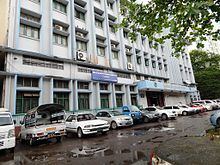No. of listings 2 Currency Burmese kyat | Key people Soe Thane ( Resigned ) Website www.msecmyanmar.com Date founded June 1996 | |
 | ||
Owner | ||
The Myanmar Securities Exchange Centre (MSEC), located in Yangon, Myanmar, is the country's only stock exchange. The exchange, a 50-50 joint venture between the state-owned Myanma Economic Bank and the Daiwa Securities Group, currently lists only two securities, both of which are rarely traded. This over-the-counter (OTC) market is planned to be replaced by the Yangon Stock Exchange by 2015.
Contents
History
The MSEC is the country's second stock exchange after the Rangoon Stock Exchange, which traded shares of a few British and American stocks in the 1930s. The fledgling exchange, operated by seven European firms, was a secondary OTC market with most of the quotes sourced from Calcutta and Bombay exchanges. It closed down at the outbreak of World War II. The RSE was revived in the late 1950s to trade shares of nine public-private joint-venture corporations. But this OTC market too died in the 1960s when all the firms were nationalized by the military government that seized power in 1962.
Another military government came to power in 1988, and it allowed the state-owned Myanma Economic Bank to form a 50-50 joint-venture with Daiwa Securities in April 1996. The Myanmar Securities Exchange Centre was formed with an authorized capital of 17 million USD and paid-up capital of 3.4 million USD in June 1996. It listed two public-private joint-venture firms: Forest Products Joint Venture Corporation and Myanmar Citizens Bank. The exchange began its trading operations in December 1996.
Current status
Currently, the Myanmar exchange is dormant considering that no new companies are listing in the bourse. Instead, the government plans to set up another bourse. No new companies have signed up beyond the first two, and there is little trading. A 2011 Reuters report states that the exchange had no trading floor, and had eight employees who handled over-the-counter transactions and manually updated share prices, using a whiteboard, a marker pen and a stencil whenever a customer dropped by. Indeed, most people do not even know that the market exists at all. State-owned and private enterprises alike have chosen not to list. Their reasons include the firm's fear of tax liability, fear of loss of control and unfamiliarity with the corporate culture.
Future plans
The MSEC is slated to be replaced by a new full-fledged exchange. In 2011, the government of Thein Sein selected Daiwa and Tokyo Stock Exchange to help set up a functioning stock market by 2015. With their assistance, the Central Bank of Myanmar drafted a "Securities Exchange Law", which authorizes the Yangon Stock Exchange (YSE), and was signed into law on 31 July 2013.
The Yangon Stock Exchange, expected to open by October 2015, will be run by Yangon Stock Exchange Joint-Venture Company Limited, a joint venture company with Myanma Economic Bank (51%), the Daiwa Institute of Research Ltd of the Daiwa Securities Group (30.25%), and Japan Exchange Group (18.75%).
The new exchange still faces many challenges. By one estimate, less than one-third of the approximately 70 local public companies in the country are expected to qualify for listing. Even those that qualify may still not list for the same reasons—especially the issue of taxes—that have prevented them from listing on the MSEC in the first place. Moreover, the country's securities companies, accounting firms and law firms are sufficient to support only a small capital market. A Daiwa executive estimates “between five and 10” companies to list during the YSE’s first year of operation in 2015, with 10 to 20 listed by the end of 2017. Even this may prove optimistic if the experience of the country's two smaller neighbors, Cambodia and Laos, is any guide. In July 2013, the Lao Securities Exchange had only two listed companies, while the Cambodia Securities Exchange had one.
According to deputy minister of the Ministry of Finance and Revenue Maung Maung Thein, six private companies with "impressive business performances" have proposed to be listed on the new exchange. The deputy minister also declared in a statement that the stock exchange will principally allow stock trading at the start of the operations before gradually moving on to the bond market and will take on the derivatives and futures markets at the next stage.
